AMD Kaveri Review: A8-7600 and A10-7850K Tested
by Ian Cutress & Rahul Garg on January 14, 2014 8:00 AM ESTCPU Performance
I often make a big song and dance about real world benchmarks being the main focus of a reviewer. Synthetics often stress parts of the CPU and distort advantages that a CPU might have and thus not affect you or me in the same manner when using the machine normally. For 2014 I have updated my usual benchmarking set, to include more video encoding and an image converter that takes 2D images and performs algorithms to convert the data into a 3D model. Some 2013 benchmarks are still here, showing what can be done, and to bring parity to previous CPU reviews, some synthetics are also included.
Agisoft Photoscan v1.0 - link
Our new main benchmark to AnandTech is provided by Agisoft. Their Photoscan software creates 3D models from 2D images, a process which is very computationally expensive. The algorithm is split into four distinct phases, and different phases of the model reconstruction require either fast memory, fast IPC, more cores, or even OpenCL compute devices to hand. Agisoft supplied us with a special version of the software to script the process, where we take 50 images of a stately home and convert it into a medium quality model. This benchmark typically takes around 15-20 minutes on a high end PC on the CPU alone, with GPUs reducing the time.
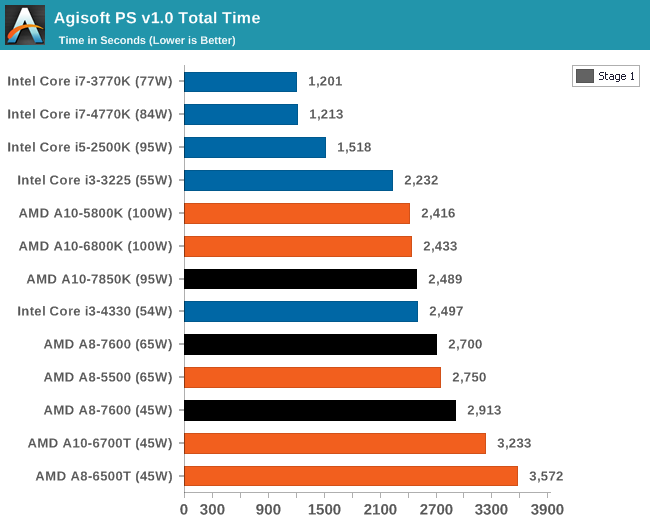
AMD suffers in overall time due to the lack of full-blooded cores and the reliance on single threaded performance in certain parts of the algorithm.
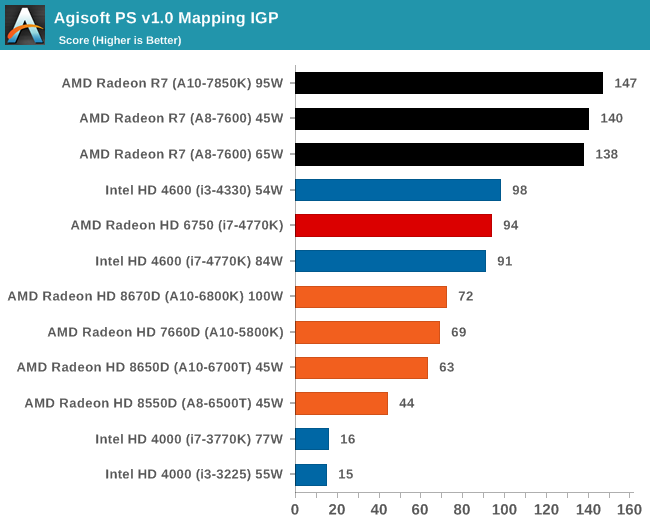
The second stage of the benchmark can be accelerated by the IGP of an APU, and as a result we can see the power of the high end APUs for this work can outshine any CPU we tested today. This is really the promise of HSA, it's just going to take a while to get there for most apps.
3D Particle Movement - link
3DPM is a self-penned benchmark, taking basic 3D movement algorithms used in Brownian Motion simulations and testing them for speed. High floating point performance, MHz and IPC wins in the single thread version, whereas the multithread version has to handle the threads and loves more cores.
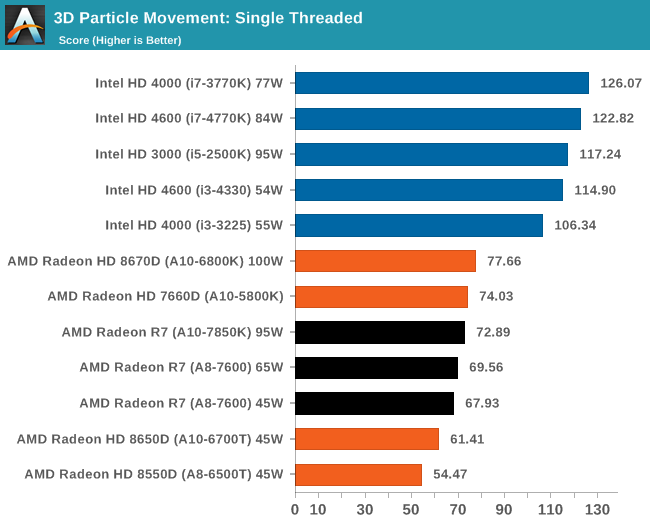
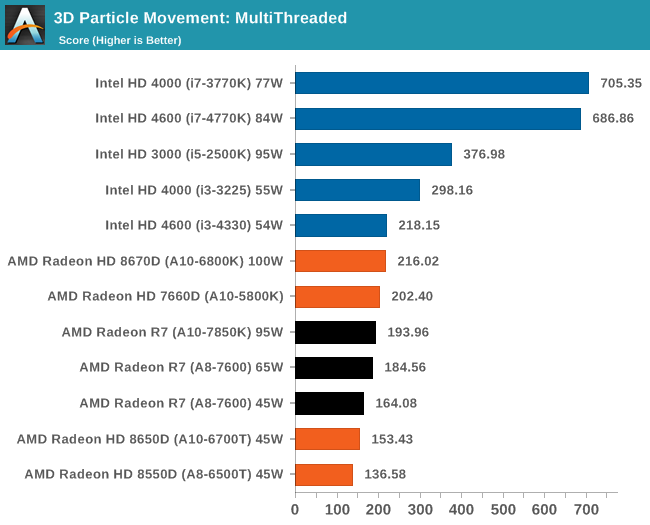
AMD is still suffering a lack of FP performance in our 3DPM benchmark.
WinRAR 5.01 - link
Our WinRAR test from 2013 is updated to the latest version of WinRAR at the start of 2014. We compress a set of 2867 files across 320 folders totaling 1.52 GB in size – 95% of these files are small typical website files, and the rest (90% of the size) are small 30 second 720p videos.
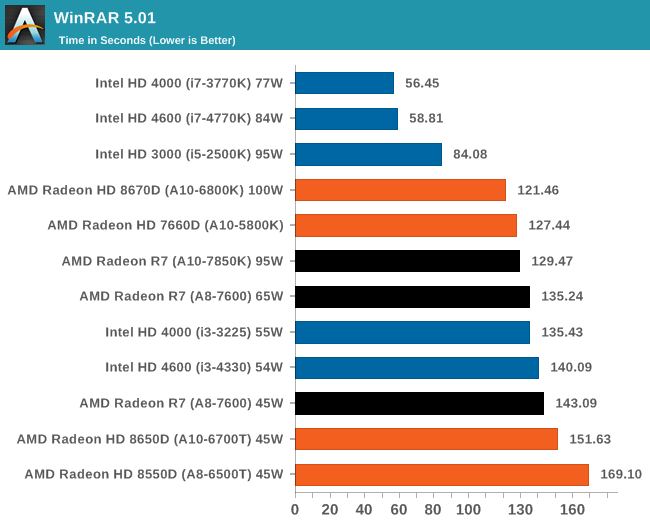
WinRAR loves IPC from the high end Intel chips, but even against the older i5-2500K there is still a deficit. The 45W Kaveri APU however is within fighting distance of its main rival.
FastStone Image Viewer 4.9 - link
Similarly to WinRAR, the FastStone test us updated for 2014 to the latest version. FastStone is the program I use to perform quick or bulk actions on images, such as resizing, adjusting for color and cropping. In our test we take a series of 170 images in various sizes and formats and convert them all into 640x480 .gif files, maintaining the aspect ratio. FastStone does not use multithreading for this test, and thus single threaded performance is often the winner.
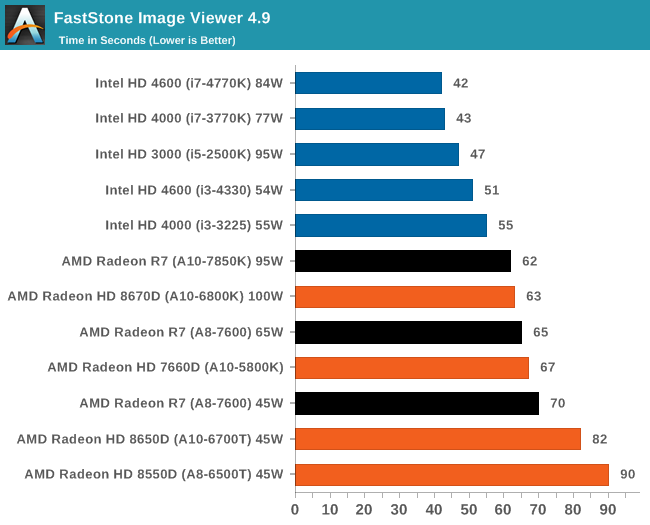
FastStone wants single threaded performance, so Intel wins here again.










380 Comments
View All Comments
boozed - Tuesday, January 14, 2014 - link
You must be a hoot at parties.boozed - Wednesday, January 15, 2014 - link
And I hit reply on the wrong bloody comment. My apologies...monsieurrigsby - Wednesday, January 29, 2014 - link
I'm a bit slow to the party, but talk of discrete GPUs leads me to the main question I still have that I don't see explained (possibly because the authors assume deeper understanding of CPU/GPU programming), and haven't seen discussed elsewhere. (I've not looked *that* hard...)If you have a Kaveri APU and a mid/high-end discrete GPU that won't work with Dual Graphics (if it arrives), what processing can and can't use the on-APU GPU? If we're talking games (the main scenario), what can developers offload onto the onboard GPU and what can't they? What depends on the nature of the discrete card (e.g., are modern AMD ones 'HSA enabled' in some way?)? If you *do* have a Dual Graphics capable discrete GPU, does this still limit what you can *explicitly* farm off to the onboard GPU?
My layman's guess is that GPU compute stuff can still be done but, without dual graphics, stuff to do with actual frame rendering can't. (I don't know enough about GPU programming to know how well-defined that latter bit is...)
It's just that that seems the obvious question for the gaming consumer: if I have a discrete card, in what contexts is the on-APU GPU 'wasted' and when could it be used (and how much depends on what the discrete card is)? And I guess the related point is how much effort is the latter, and so how likely are we to see elements of it?
Am I missing something that's clear?
monsieurrigsby - Wednesday, January 29, 2014 - link
Plus detail on Mantle seems to suggest that this might provide more control in this area? But are there certain types of things which would be *dependent* on Mantle?http://hothardware.com/News/How-AMDs-Mantle-Will-R...
nissangtr786 - Tuesday, January 14, 2014 - link
I told amd fanboys the fpu on intel and the raw mflops mips ofintel cpu destroy current a10 apus, its no real suprise all those improvement show very little in benchmarks with kaveri steamroller cores. amd fanboys said it will reach i5 2500k performance, I said i3 4130 but overall i3 4130 will be faster in raw performance and I am right. I personally have an i5 4430 and it looks like i5's still destroy these a10 apu in raw performance.http://browser.primatelabs.com/geekbench3/326781
browser.primatelabs.com/geekbench3/321256
a10-7850k Sharpen Filter Multi-core 5846 4.33 Gflops
browser.primatelabs.com/geekbench3/321256
i5 4430 Sharpen Filter Multi-core 11421 8.46 Gflops
gngl - Tuesday, January 14, 2014 - link
"I personally have an i5 4430 and it looks like i5's still destroy these a10 apu in raw performance."You seem to have a very peculiar notion of what "raw performance" means, if you're measuring it in terms of what one specific benchmark does with one specific part of the chip. There's nothing raw about a particular piece of code executing a specific real-world benchmark using a particular sequence of instructions.
chrnochime - Tuesday, January 14, 2014 - link
Who cares what CPU you have anyway. If you want to show off, tell us you have at least a 4670k and not a 4430. LOLkeveazy - Tuesday, January 14, 2014 - link
It's relevant that he used the i5 4430 in his comment. Compare the price range and you'll see. These AMD apu's are useless unless your just looking to build a PC that's not meant to handle heavily threaded tasks.tcube - Thursday, January 16, 2014 - link
Ok... heavily threaded tasks ok... examples! Give me one example of one software 90% of pc users use 90% of the time that this apu can't handle... then and ONLY then is the cpu relevant! Other then that it's just bragging rights and microseconds nobody cares about on a PC!Instead we do care to have a chip that plays anything from hd video to AAA 3d games and also is fast enough for anything else and don't need a gpu for extra cost, power usage heat and noise! And that ain't any intel that fits on a budget!
keveazy - Saturday, January 18, 2014 - link
I'll give you 1 example. Battlefield 4.